Question Number 157139 by chuxx last updated on 20/Oct/21
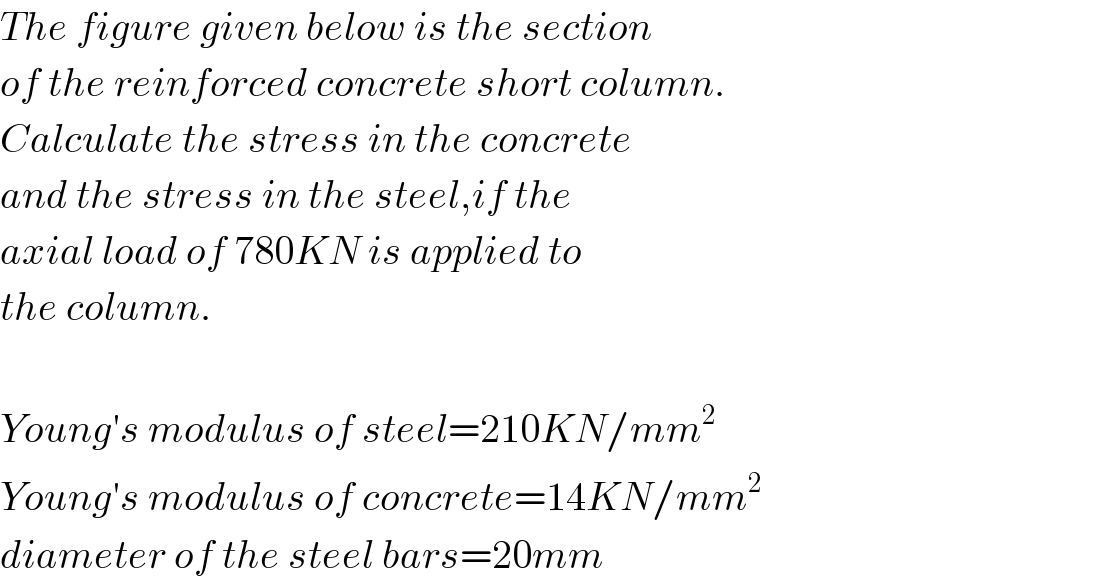
$${The}\:{figure}\:{given}\:{below}\:{is}\:{the}\:{section} \\ $$$${of}\:{the}\:{reinforced}\:{concrete}\:{short}\:{column}. \\ $$$${Calculate}\:{the}\:{stress}\:{in}\:{the}\:{concrete} \\ $$$${and}\:{the}\:{stress}\:{in}\:{the}\:{steel},{if}\:{the} \\ $$$${axial}\:{load}\:{of}\:\mathrm{780}{KN}\:{is}\:{applied}\:{to} \\ $$$${the}\:{column}. \\ $$$$ \\ $$$${Young}'{s}\:{modulus}\:{of}\:{steel}=\mathrm{210}{KN}/{mm}^{\mathrm{2}} \\ $$$${Young}'{s}\:{modulus}\:{of}\:{concrete}=\mathrm{14}{KN}/{mm}^{\mathrm{2}} \\ $$$${diameter}\:{of}\:{the}\:{steel}\:{bars}=\mathrm{20}{mm} \\ $$
Commented by chuxx last updated on 20/Oct/21

Answered by mr W last updated on 20/Oct/21
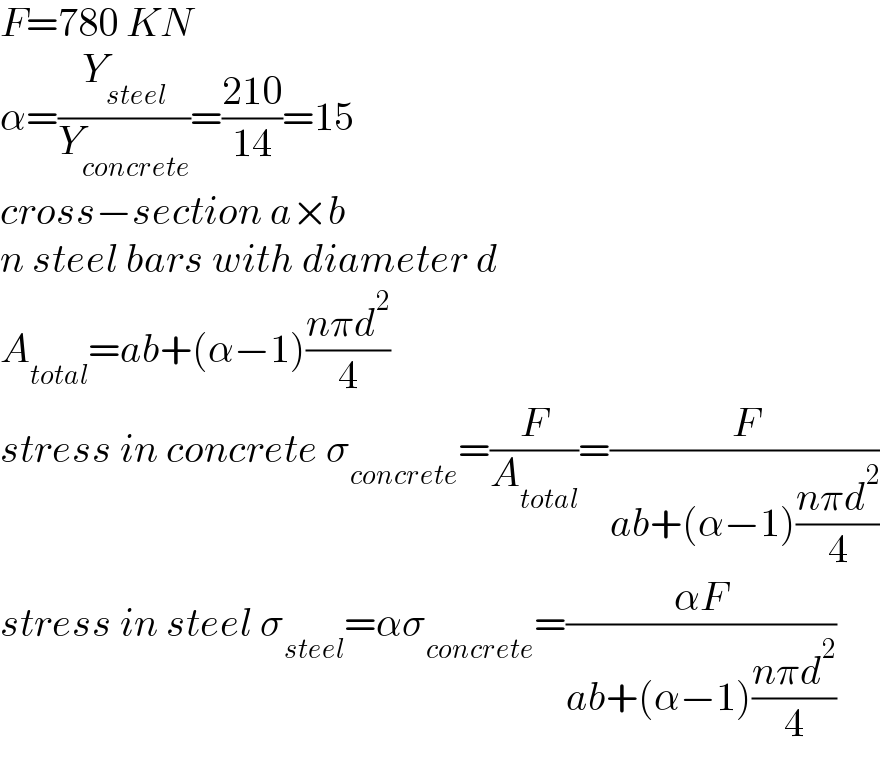
$${F}=\mathrm{780}\:{KN} \\ $$$$\alpha=\frac{{Y}_{{steel}} }{{Y}_{{concrete}} }=\frac{\mathrm{210}}{\mathrm{14}}=\mathrm{15} \\ $$$${cross}−{section}\:{a}×{b} \\ $$$${n}\:{steel}\:{bars}\:{with}\:{diameter}\:{d} \\ $$$${A}_{{total}} ={ab}+\left(\alpha−\mathrm{1}\right)\frac{{n}\pi{d}^{\mathrm{2}} }{\mathrm{4}} \\ $$$${stress}\:{in}\:{concrete}\:\sigma_{{concrete}} =\frac{{F}}{{A}_{{total}} }=\frac{{F}}{{ab}+\left(\alpha−\mathrm{1}\right)\frac{{n}\pi{d}^{\mathrm{2}} }{\mathrm{4}}} \\ $$$${stress}\:{in}\:{steel}\:\sigma_{{steel}} =\alpha\sigma_{{concrete}} =\frac{\alpha{F}}{{ab}+\left(\alpha−\mathrm{1}\right)\frac{{n}\pi{d}^{\mathrm{2}} }{\mathrm{4}}} \\ $$
Commented by chuxx last updated on 20/Oct/21

$${please}\:{recommend}\:{any}\:{textbook}\:{for} \\ $$$${me}.\:{The}\:{ones}\:{I}'{ve}\:{seen}\:{arent}\: \\ $$$${comprehensive}= \\ $$
Commented by mr W last updated on 20/Oct/21
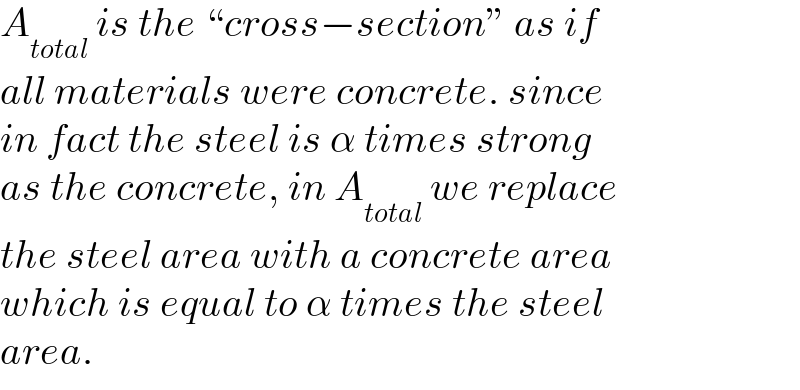
$${A}_{{total}} \:{is}\:{the}\:“{cross}−{section}''\:{as}\:{if} \\ $$$${all}\:{materials}\:{were}\:{concrete}.\:{since} \\ $$$${in}\:{fact}\:{the}\:{steel}\:{is}\:\alpha\:{times}\:{strong} \\ $$$${as}\:{the}\:{concrete},\:{in}\:{A}_{{total}} \:{we}\:{replace} \\ $$$${the}\:{steel}\:{area}\:{with}\:{a}\:{concrete}\:{area} \\ $$$${which}\:{is}\:{equal}\:{to}\:\alpha\:{times}\:{the}\:{steel} \\ $$$${area}. \\ $$
Commented by chuxx last updated on 20/Oct/21

$${Thank}\:{you}\:{so}\:{much}.\:\:{It}'{s}\:{been}\:{a}\:{long} \\ $$$${time}. \\ $$
Commented by chuxx last updated on 20/Oct/21
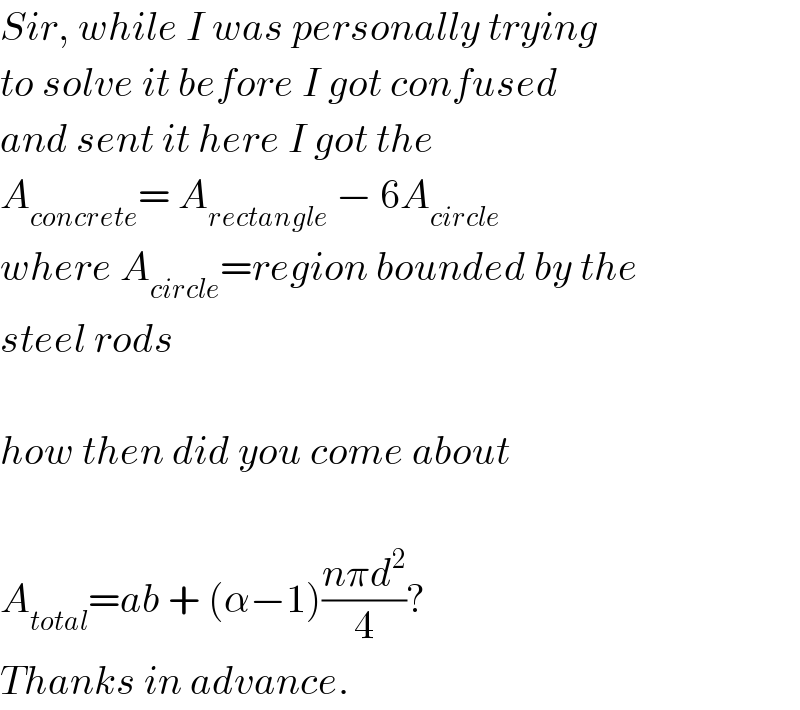
$${Sir},\:{while}\:{I}\:{was}\:{personally}\:{trying} \\ $$$${to}\:{solve}\:{it}\:{before}\:{I}\:{got}\:{confused} \\ $$$${and}\:{sent}\:{it}\:{here}\:{I}\:{got}\:{the}\: \\ $$$${A}_{{concrete}} =\:{A}_{{rectangle}} \:−\:\mathrm{6}{A}_{{circle}} \\ $$$${where}\:{A}_{{circle}} ={region}\:{bounded}\:{by}\:{the} \\ $$$${steel}\:{rods} \\ $$$$ \\ $$$${how}\:{then}\:{did}\:{you}\:{come}\:{about} \\ $$$$ \\ $$$${A}_{{total}} ={ab}\:+\:\left(\alpha−\mathrm{1}\right)\frac{{n}\pi{d}^{\mathrm{2}} }{\mathrm{4}}? \\ $$$${Thanks}\:{in}\:{advance}. \\ $$
Commented by mr W last updated on 20/Oct/21
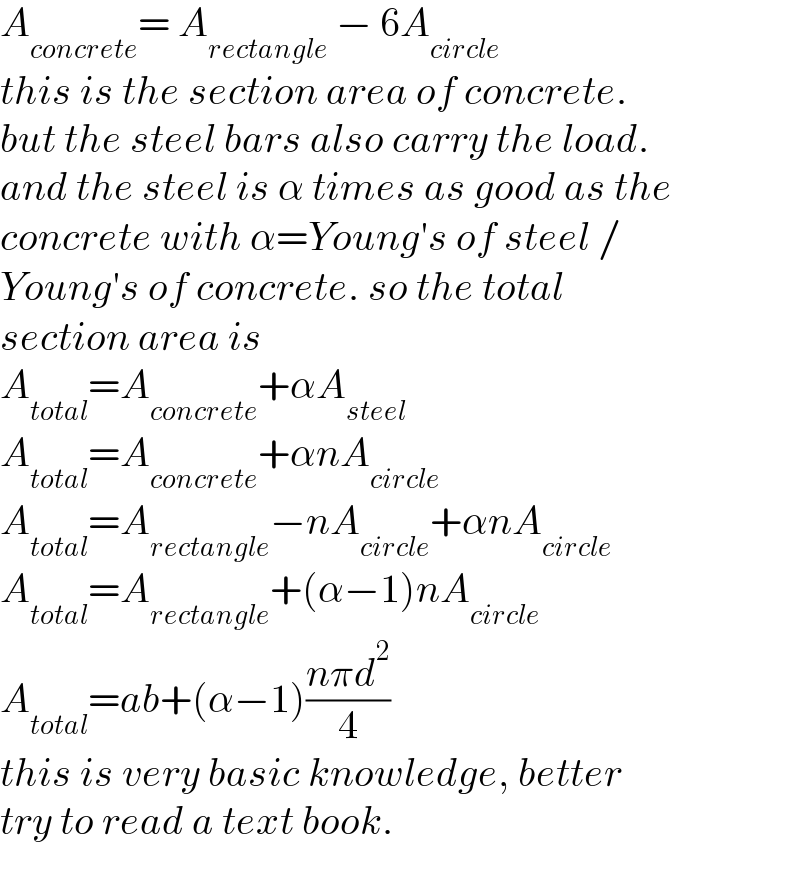
$${A}_{{concrete}} =\:{A}_{{rectangle}} \:−\:\mathrm{6}{A}_{{circle}} \\ $$$${this}\:{is}\:{the}\:{section}\:{area}\:{of}\:{concrete}. \\ $$$${but}\:{the}\:{steel}\:{bars}\:{also}\:{carry}\:{the}\:{load}. \\ $$$${and}\:{the}\:{steel}\:{is}\:\alpha\:{times}\:{as}\:{good}\:{as}\:{the} \\ $$$${concrete}\:{with}\:\alpha={Young}'{s}\:{of}\:{steel}\:/ \\ $$$${Young}'{s}\:{of}\:{concrete}.\:{so}\:{the}\:{total} \\ $$$${section}\:{area}\:{is} \\ $$$${A}_{{total}} ={A}_{{concrete}} +\alpha{A}_{{steel}} \\ $$$${A}_{{total}} ={A}_{{concrete}} +\alpha{nA}_{{circle}} \\ $$$${A}_{{total}} ={A}_{{rectangle}} −{nA}_{{circle}} +\alpha{nA}_{{circle}} \\ $$$${A}_{{total}} ={A}_{{rectangle}} +\left(\alpha−\mathrm{1}\right){nA}_{{circle}} \\ $$$${A}_{{total}} ={ab}+\left(\alpha−\mathrm{1}\right)\frac{{n}\pi{d}^{\mathrm{2}} }{\mathrm{4}} \\ $$$${this}\:{is}\:{very}\:{basic}\:{knowledge},\:{better} \\ $$$${try}\:{to}\:{read}\:{a}\:{text}\:{book}. \\ $$
Commented by chuxx last updated on 20/Oct/21

$${I}'{ll}\:{also}\:{like}\:{to}\:{ask}\:{sir},\:{what}\:{is}\:{the} \\ $$$${difference}\:{between}\:{the}\:{cross}-{section} \\ $$$${and}\:{A}_{{total}} ;\:{I}\:{thought}\:{they}\:{were} \\ $$$${supposed}\:{to}\:{be}\:{the}\:{same}. \\ $$
Commented by mr W last updated on 20/Oct/21

$${i}\:{can}'{t}\:{recomment}\:{you}\:{a}\:{text}\:{book}, \\ $$$${since}\:{in}\:{fact}\:{i}\:{don}'{t}\:{read}\:{book}\:{either}. \\ $$$${what}\:{i}\:{told}\:{you}\:{above}\:{is}\:{directly}\:{from} \\ $$$${my}\:{own}\:{understanding}\:{of}\:{the}\:{physics}.\: \\ $$
Commented by chuxx last updated on 20/Oct/21

$${I}\:{am}\:{most}\:{grateful}.\:{Thank}\:{you}\:{for} \\ $$$${always}\:{helping}. \\ $$
